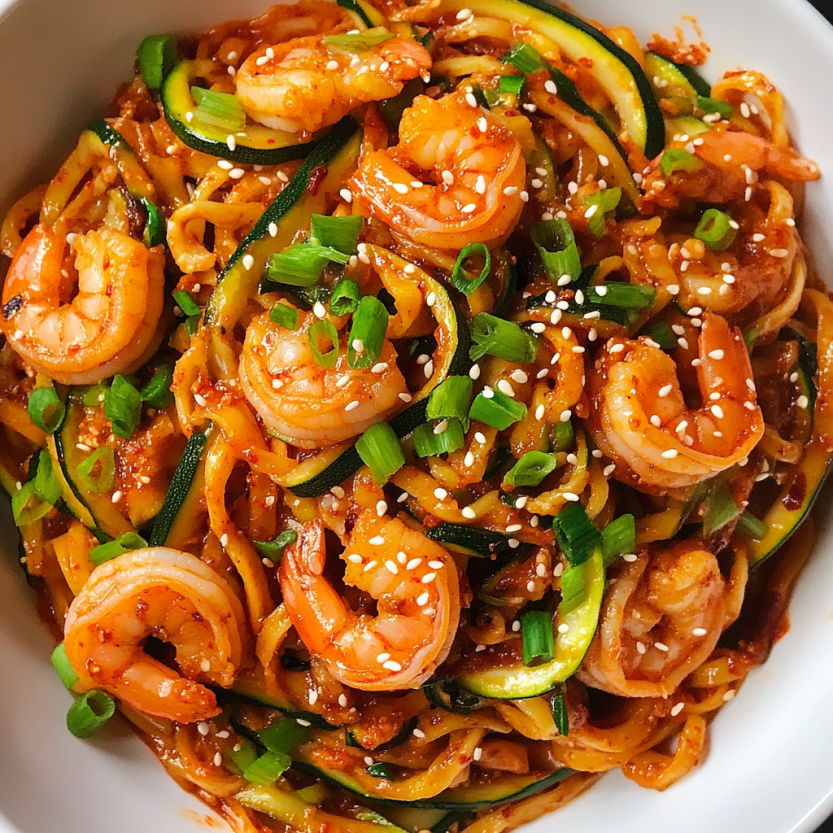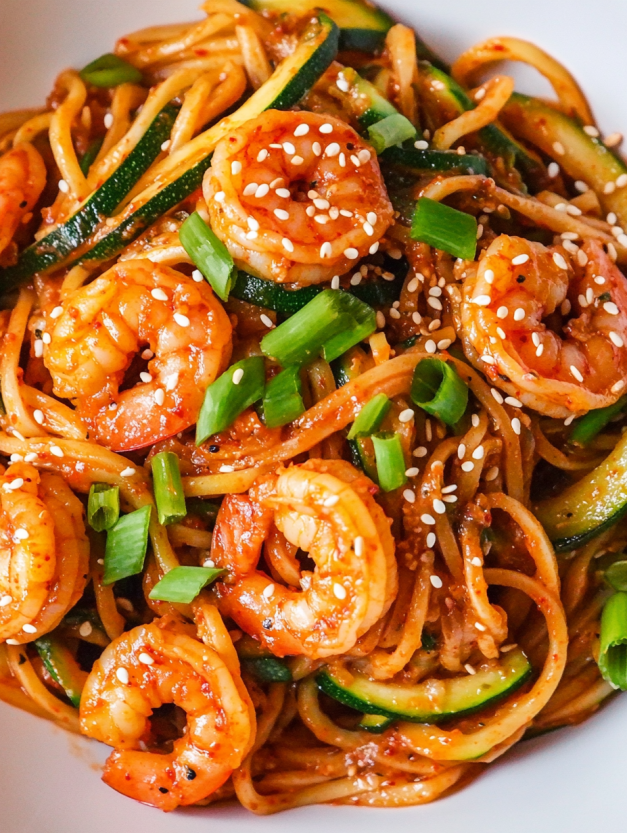 Save
Save
An easy, 25-minute recipe turning spicy, saucy gochujang noodles into a protein-packed, stir-fried recipe that won’t disappoint! This Korean spicy noodles dish is made with rice noodles, zucchini spirals, and shrimp tossed in an addicting sweet and spicy gochujang sauce.
While not a traditional Korean dish, this noodle recipe incorporates Korean flavors like spicy gochujang and rice noodles into a super easy, tasty meal.
Ingredient Notes
- Zucchini: You’ll want to get one large zucchini and spiralize it
- Shrimp: Use fresh or frozen shrimp
- Rice Noodles: Rice noodles are smooth and chewy, which helps to absorb the sauce well. Also complements well with the slightly crunchy zucchini noodles
- Avocado Oil: Or another neutral cooking oil of your choice
- Salt
- Chopped Green Onion & Sesame Seeds: Optional, for garnish
- Gochujang: Also known as Korean red pepper paste. This is a gluten-free dish, but read the label to make sure there’s no wheat in your gochujang. This brand is gluten-free
- Tamari: If you aren’t gluten-free, you can replace the tamari sauce with soy sauce. If you’re soy-free, use coconut aminos
- Water
- Almond Butter: Or your favorite nut or seed butter
- Rice Vinegar
- Coconut Sugar: You can also use brown sugar if preferred
- Toasted Sesame Oil
- Garlic Cloves: Mince fresh garlic cloves or use a jar of minced garlic
Step-by-Step Instructions
- Step 1:
- Cut the spiralized zucchini if they are too long. Place in a large colander and toss with sea salt. Let this sit while you prepare the rest of the recipe
- Step 2:
- Add all ingredients for the gochujang sauce in a bowl and whisk together to combine. Set aside
- Step 3:
- Pat dry the shrimp with a paper towel and heat avocado oil in a large skillet over medium-high heat. Add shrimp in a single layer, and pan fry for 1-2 minutes on each side until opaque. Remove the shrimp from the pan and set aside
- Step 4:
- Cook the rice noodles according to the package instructions. Drain and place in the pan that the shrimp was cooked in. Turn the heat on to medium-high, pour gochujang sauce over the noodles, and stir, cooking for 2 minutes
- Step 5:
- Squeeze the zucchini noodles to remove as much liquid as possible. Add the squeezed zucchini and shrimp to the skillet with the cooked noodles, and stir to coat in sauce
- Step 6:
- Turn off the heat, and serve sprinkled with sesame seeds and green onions
 Save
Save
Expert Tips
Spice level: This is a spicy dish, so if you want to make it less spicy – reduce the gochujang to 2-3 tbsp.
Shrimp: You can use fresh or frozen shrimp. Just be aware that with frozen shrimp you will need to thaw them before cooking, or follow the package directions for the cooking time for cooking shrimp directly from frozen.
Zucchini Noodles: If you’d prefer, you can omit the zucchini noodles and just use rice noodles.
Veggies: Feel free to add additional sauteed veggies to these gochujang noodles if you would like.
 Save
Save
Storage Tips
Store leftovers in an airtight container in the refrigerator for up to three days.
Reheat over the stovetop or in the microwave. Stir the noodles occasionally to break them up. Add more sauce and garnish, if desired.
Recipe Questions
- → Can I adjust the spice level of gochujang noodles?
Yes, reduce the gochujang to 2-3 tablespoons if you prefer a milder flavor without sacrificing the core taste.
- → What type of shrimp works best?
You can use either fresh or frozen shrimp. If frozen, make sure to thaw before cooking or follow package directions for direct use.
- → Are zucchini noodles necessary?
Zucchini noodles add texture and freshness, but you can omit them or replace with other vegetables if preferred.
- → Can I use a different protein?
Yes, chicken, tofu, or even eggs work well as alternatives to shrimp depending on your preference or dietary needs.
- → How should I store and reheat leftovers?
Store in an airtight container in the fridge for up to 3 days. Reheat on the stovetop or microwave, adding extra sauce if needed.
- → Is this dish gluten-free?
Yes, as long as you use certified gluten-free gochujang and tamari, the dish is entirely gluten-free.